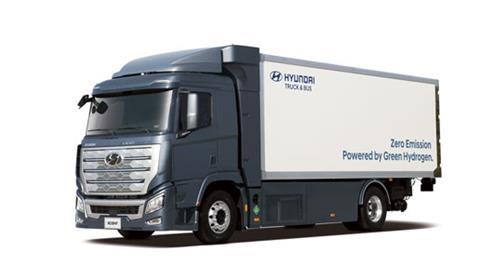
How close are we to seeing hydrogen powered trucks on UK roads? Selwyn Parker investigates.
The first of Hyundai’s hydrogen fuel cell-powered, heavy duty trucks will be put to work shortly on the roads of Switzerland in what promises to be a landmark date for the haulage industry in Europe.
Part of an order for 1,600 trucks that will be delivered between now and 2025, the vehicles will be leased out through H2 Mobility Switzerland, a consortium of refuelling stations, logistics and transport companies, in the opening wave of a bold vision for a Europe-wide, fuel cell-driven logistics sector.
Aided by increasingly stiff taxes and other financial penalties on diesel trucks, Hyundai’s grand plan is to build a base for the technology in Europe, followed by the US and other countries.
The giant South Korean manufacturer, which has been turning out fuel cell-powered cars for nearly six years, is a pioneer of the technology. In fact, Hyundai is practically betting its future on fuel-cell electric vehicles (FCEVs). By 2030, it expects to be rolling out around 500,000 passenger and commercial FCEVs a year. And Switzerland is where it starts.
“Hyundai expects to gain a foothold in Switzerland where the demand for fuel-cell trucks is expected to grow from a stiff nationwide road tax on diesel trucks,” H2 Mobility states. “This incentivises fleet operators to switch to zero-emission vehicles.”
Rolf Huber, chairman of leasing group H2 Energy, is extremely bullish, describing it as “an unstoppable momentum towards eco-friendly mobility for heavy duty trucks in Europe and beyond”.
In this, he echoes the views of Nikola Motors, the start-up American manufacturer known as ‘the Tesla of trucks’. The Arizona-based company is bold enough to predict diesel-free roads in Europe within a few years as combustion-engined trucks are progressively withdrawn.
In the meantime, other truck makers including Toyota (one of the first off the mark), Mercedes-Benz and Ford are exploring hydrogen propulsion while simultaneously working on pure battery electric trucks.
But the next manufacturer to roll out fuel cell-powered trucks will be Nikola, which is within two years of putting trucks in showrooms. Initially, the trucks will be manufactured by Fitzgerald while Nikola builds its own plant. So far it has an order book of 14,000 for its three models, including one designed for Europe, the Nikola Tre, which president Mark Russell said will have a range of 500 to 700 miles, depending on the load, and can be refuelled in under 15 minutes.
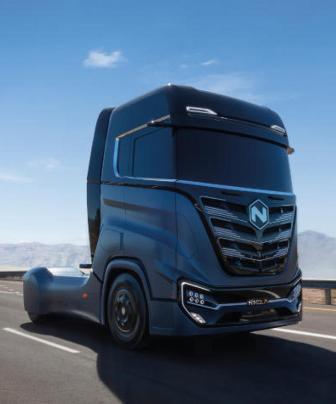
“We’ll have 100 or so trucks in test production before 2022 when full production begins,” a spokeswoman said.
It costs nothing to put your name down for a Nikola truck, however, so the 14,000-strong order book may prove somewhat illusory.
More promisingly, brewer Anheuser Busch of Budweiser fame has made a firm booking for 800 Class 8 trucks, weighing at least 33,000 pounds (15,000kg), as part of its sustainability policy. And there’s undeniably a huge market in America where most goods are transported
by heavy duty trucks.
Why hydrogen?
Hydrogen power is widely accepted as one of the cleanest forms of propulsion. The only tailpipe emission is water vapour, albeit heated. There is a significant climate-related problem though: currently nearly all hydrogen is produced from fossil fuels. Although that’s changing,
it will be some time before all hydrogen is derived from renewables, mainly because there’s not enough renewable energy to go around. Until there is, companies like Nikola, which will use solar power at its refuelling stations, will supplement supplies from the grid.
However that’s just the case for now. There’s a ferment of science going on in the labs as alternative technologies are developed for hydrogen storage. Just one promising development is ‘surface storage’ in which a kind of metal dust made of various compounds can be converted to
hydrogen by adding water.
In July, another interesting development emerged when a research team from Lancaster University identified a method of making smaller, cheaper and more energy-dense fuel cell storage systems. Leading researcher Professor David Antonelli said: “We could see hydrogen fuel cell systems that cost five times less than lithium-ion batteries.”
Even more impressive, he foresees “much longer range – potential journeys up to four or five times longer”.
The technology of hydrogen fuel cells isn’t new, however. They were used in the original space rockets in the early 1960s and helped get the first men to the moon. However they were so expensive that it was years before the technology was applied to transport on terra firma.
Proving viability
Hyundai’s line-up shows that fuel cell trucks are viable. Building on its experience with hydrogen-powered cars, Hyundai has equipped its trucks with two hydrogen fuel cell stacks driving electric motors. It’s a 190kW system with a range of around 400km, depending on the load. There are eight large hydrogen tanks, mainly between the cabin and the rigid body.
The big question now is how hydrogen-powered trucks perform relative to diesels. Essentially, as long as there’s hydrogen in the tank, the truck will go. The electric motors are the same as those installed in electric vehicles. The difference is that the energy doesn’t come from a battery but from a fuel cell powered by hydrogen.
Hydrogen fuel cells are lighter than batteries but, because the motor is still electric, the trucks have more horsepower and accelerate faster than diesel trucks – roughly twice as fast, in fact.
The virtues of fuel-cell trucks come at a high price for the moment, though. In the US, hydrogen fuel is currently subsidised; otherwise it would probably be priced out of the market. In Britain, hydrogen refuelling stations are indirectly subsidised by the government, which helps keep down costs. However the price of hydrogen is falling just about everywhere and will continue to.
“Costs will change massively over the next few years,” predicts H2Powergroup’s head of consulting, Mike Dixon.
Overall maintenance costs are much cheaper, as they are for electric trucks, because there are fewer moving parts. Even brake wear is down because stopping power is boosted by the energy storage system, as in F1 cars.
High price
As for the cost of the trucks, the full price of Hyundai’s FCEVs is unclear because they will be leased. However in the US, Nikola Motors’ Class 8 rig is expected to retail for $375,000 (£308,000) when it goes into production in 2022, compared with $180,000 for the all-electric Tesla
Semi with a 500-mile range. A comparable diesel truck sells for about $120,000.
The essential technology – the fuel cell – is steadily coming down in price. US-based Ballard’s latest module – FCmove, introduced in June –is a third cheaper than its predecessor. There’s no clear timeline in which fuel cell-powered trucks will achieve price parity with diesel, but, predicts Guy McAree, director of investor relations at Ballard: “Cost-of-ownership comparisons show fuel cell-powered buses coming down to comparable cost levels with battery-powered alternatives by 2020.”
Refuelling is similar to topping up with diesel or natural gas, and both simpler and faster than recharging a battery. Nikola claims a 15-minute refuel will take one of its trucks up to 750 miles, more than twice as far as current all-electric trucks.
But, as Ballard’s McAree pointed out, a lot of trucks work from base. “If the truck is part of a fleet that returns to a depot at the end of the day, then a single hydrogen fuelling station may be all that’s required,” he said. “Of course the challenge of deploying hydrogen infrastructure
across a wide geographic area is still an issue to be fully addressed.”
The arguments about scarcity of supply are pretty much exactly the same as for electric charging stations a few years ago. Not only has electric recharging technology improved rapidly, but coverage is widening in the UK and elsewhere in Europe. And Nikola is already working with an industry consortium on a worldwide fuelling network that aims to have 700 stations up and running in the US by 2028 that will produce their own hydrogen by electrolysis and store the fuel on-site.
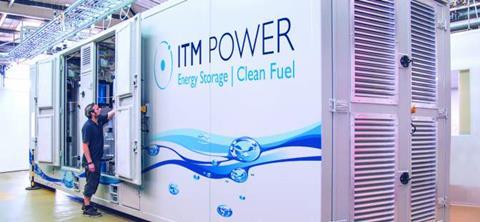
History suggests the number of refuelling points catches up rapidly to satisfy emerging demand once the practicalities of a new form of transport start to sink in. If there’s money to be made, the transport industry rapidly responds.
FCEVs v BEVs
The relative merits of hydrogen-powered trucks and battery-electric ones are hotly debated, but the main issue comes down to range. “The [battery-electric] equipment we’ve tested has a range of 100 miles and that just won’t work for trucking,” Chris Cannon, chief sustainability officer for the Port of Los Angeles, the US’s biggest port complex, told the California Hydrogen Business Council earlier this year.
Working with Toyota, Kenworth, UPS and Shell, the port is part of a hydrogen pilot programme that is putting 10 fuel-cell trucks through their paces. They are fuelled by two Shell stations.
Ballard is one of the partners involved in the Port of Los Angeles trial. “In terms of trucks, our technology is embedded in 500 delivery vans in Shanghai that have been licensed. Over 300 of them are deployed and operating,” McAree said. “We are also powering several UPS delivery vans in trials in California. And we are powering the Kenworth drayage truck in the Port of Los Angeles.”
While batteries are admittedly becoming more powerful thanks to intense development in Asia and America, BEV trucks are nowhere near competing on range.
“Hauliers don’t want to have to stop every 190 miles for one or two hours to recharge,” said Dixon of H2powergroup. He believes that eventually, BEV trucks will be mainly used for shorter runs, for instance in cities, while fuel cell trucks do the long-haul work.
Hydrogen hybrids
In the meantime, the economies of scale are looking better for hydrogen. In Berlin, DHL Express has gone for an interim hybrid arrangement in the form of a fleet of electric delivery vehicles boosted with a fuel cell. Known as the H2 Panel Van 9, the 4.5-tonne vehicle, with a cargo capacity of more than 10cu m and a maximum payload of over 800kg, will have a range of up to 500km, according to its manufacturer, Street Scooter. DHL expects to build up to a 100-strong fleet of the vans between 2020 and 2021.
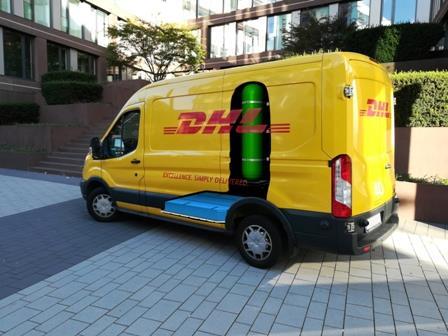
“With the H2 Panel Van, DHL Express becomes the first express provider to use a large number of electric vehicles with fuel cells for last-mile logistics,” said chief executive Markus Reckling.
In the next few years, most experts say that pressure will be brought to bear on diesel trucks and some of that will come from the world’s ports. That’s because they’re in the climate-change firing line.
According to the United Nations Intergovernmental Panel on Climate Change, coastlines (and thus ports) face a rise of up to 76cm in sea level, causing “catastrophic effects”.
That’s why, as the Port of Los Angeles’ Cannon points out, ports around the world will start charging hauliers and cargo owners that don’t use the cleanest technologies available. “We need to transition drayage trucks to near zero in the short term and ultimately to zero emission by 2035,” he said.
Clearly, this kind of talk puts an eventual deadline on diesel trucks. Under California’s clean-air action plan, for example, politicians are considering an accelerating phase out of diesel trucks, a measure that other states will be watching closely.
Closer to home, there’s a belated government push in the UK for the adoption of hydrogen that will include transport. “For heavy goods vehicles hydrogen fuel cells are the only viable option for the future,” predicted H2powergroup’s Dixon. “They are the only zero-emission
option.”
So how long will it take? Dixon estimates up to 24 months before hydrogen fuel cell-powered HGVs will be on the roads in Britain. But the infrastructure, clearly, still has a long way to go.
Hydrogen is not only for fuel cells
Hydrogen vehicle convertor ULEMCo and its R&D partner Revolve Technologies say they have achieved “record breaking energy efficiency results” for a 100% hydrogen fuelled zero emission engine, with thermal efficiencies of 45% demonstrated for the Mega Low Emissions (MLE) Volvo FH16 truck demonstrator unveiled last year. This points to the realistic prospect of zero emission trucks running on 100% hydrogen using ULEMCo’s approach of adapting existing diesel engines to run on hydrogen/diesel dual fuel, providing routes to quicker adoption of zero emissions hydrogen vehicles in heavy duty applications.
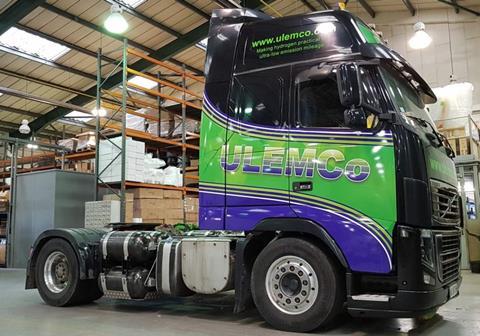
Unlike other hydrogen-fuelled vehicles, the MLE truck will use hydrogen to power the vehicle with a combustion engine rather than fuel cells and an electric motor. But there are none of the usual emissions from internal combustion engines such as unburnt fuel, particulates and carbon monoxide, and the NOx levels are immeasurably low.
ULEMCo believes that using conventional engines and existing truck designs, rather than the full transformation needed for electrification, the timeframe to the target of zero carbon emissions can be shortened significantly, at the same time dramatically reducing the cost for customers.
As a hydrogen vehicle can be refuelled quickly, fleet operators can also plan for similar numbers of vehicles to their current operation, rather than needing to increase fleet size to cover lengthy charging times for EVs.
“These excellent results represent engine efficiency levels very similar to those seen with some fuel cell technologies,” said Amanda Lyne, MD of ULEMCo. “Combining these results with our knowledge of how to ensure the engine can operate over a wide performance curve – and with industrial grade hydrogen – gives us confidence in this approach.
"Operators, particularly in heavy-duty applications, will have a truly cost effective option for very low-carbon and zero-emission driving in the future.”
ULEMCo has converted many vehicles from diesel to hydrogen dual-fuel, and these are in current service in the UK. The FH16 will be the first all-hydrogen example and with 300hp and 17kg of hydrogen on board, it will have a range of almost 300km.
Hydrogen refuelling network takes first steps in the UK
Almost by themselves, Shell and clean-fuel group ITM Power are developing a refuelling network in the UK for hydrogen trucks as well as buses, trains and ships – but there’s a long way to go, especially compared with other countries.
Currently there are six ITM Power-operated refuelling stations in the UK, with two more due to open soon at Gatwick and Birmingham. The price of hydrogen, which is sold in kgs rather than litres, is £10 to £15/kg, making it more expensive than all-electric and diesel. For comparison, a fuel cell-powered family car refuels for about £60.
The price of hydrogen at the pump is certain to fall in time. Most experts predict it will plummet by 70% in the next decade as more electrolysers – effectively on-site hydrogen-making plants – are installed and economies of scale work their way through the industry. And that can’t be fast enough for the International Energy Agency, a backer of hydrogen.

Earlier this year the IEA’s executive director Fatih Birol cited the absence of adequate refuelling infrastructure as a problem. “Hydrogen prices for consumers are highly dependent on how many refuelling stations there are, how often they are used and how much hydrogen is delivered per day,” he said.
However, like Hyundai’s arrangements in Switzerland, trucks will probably be leased in the UK with fuel included in the cost of the lease.
Maintenance is much cheaper than for diesel trucks because of fewer moving parts. A bonus is that FCEVs of all types are exempted from the London Congestion Charge.
Germany is one of several countries, including Japan and China, that are way ahead of the UK in refuelling infrastructure. Germany had 70 stations in operation in mid-2019 and has another 30 planned in 2020. By 2025, according to the Federal Ministry of Transport, Germany will be covered by a 400-strong network. And Japan, which plans to run a hydrogen Olympics next year with fuel cell-powered buses, is aiming for 900 stations by 2030.














